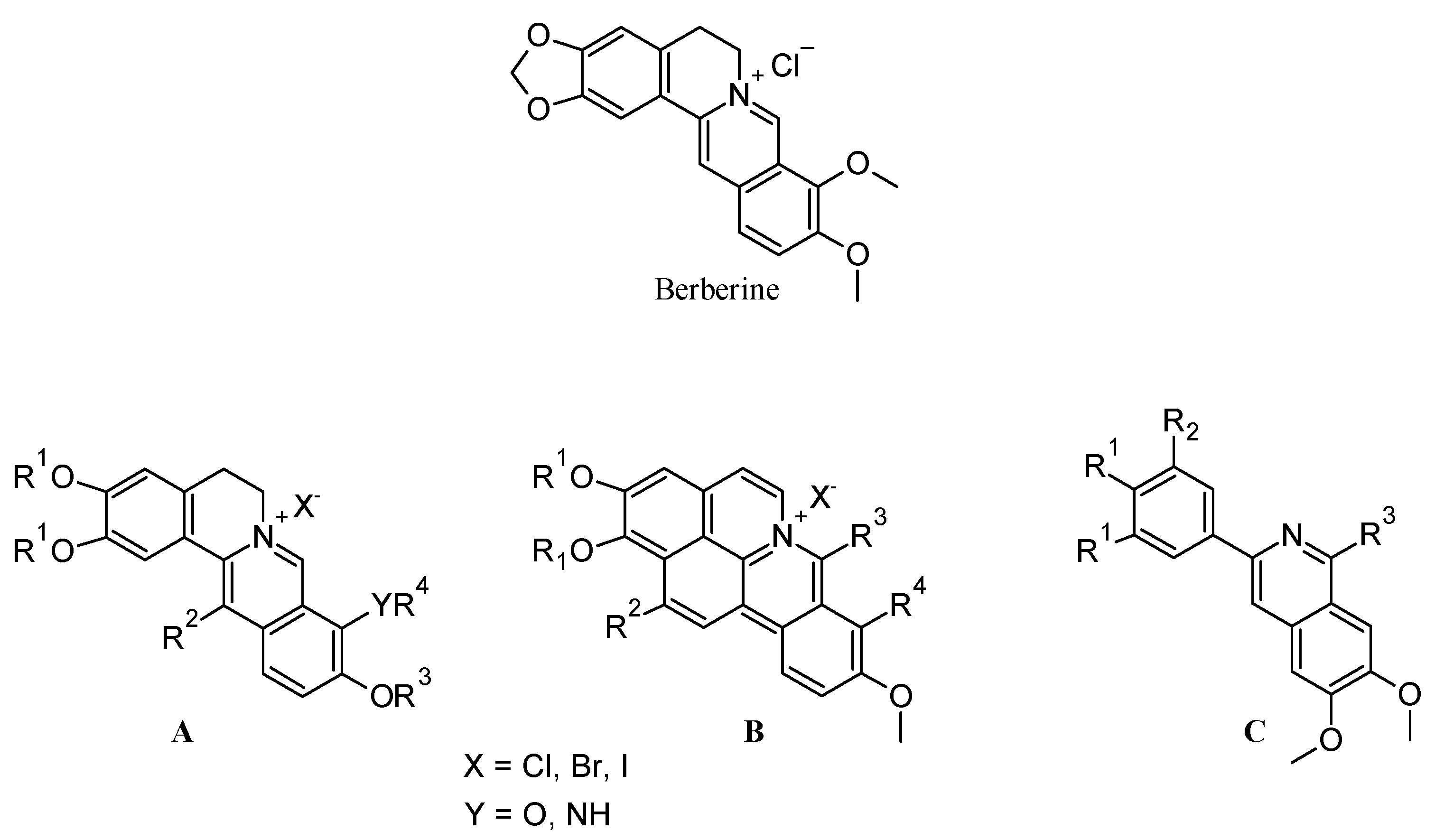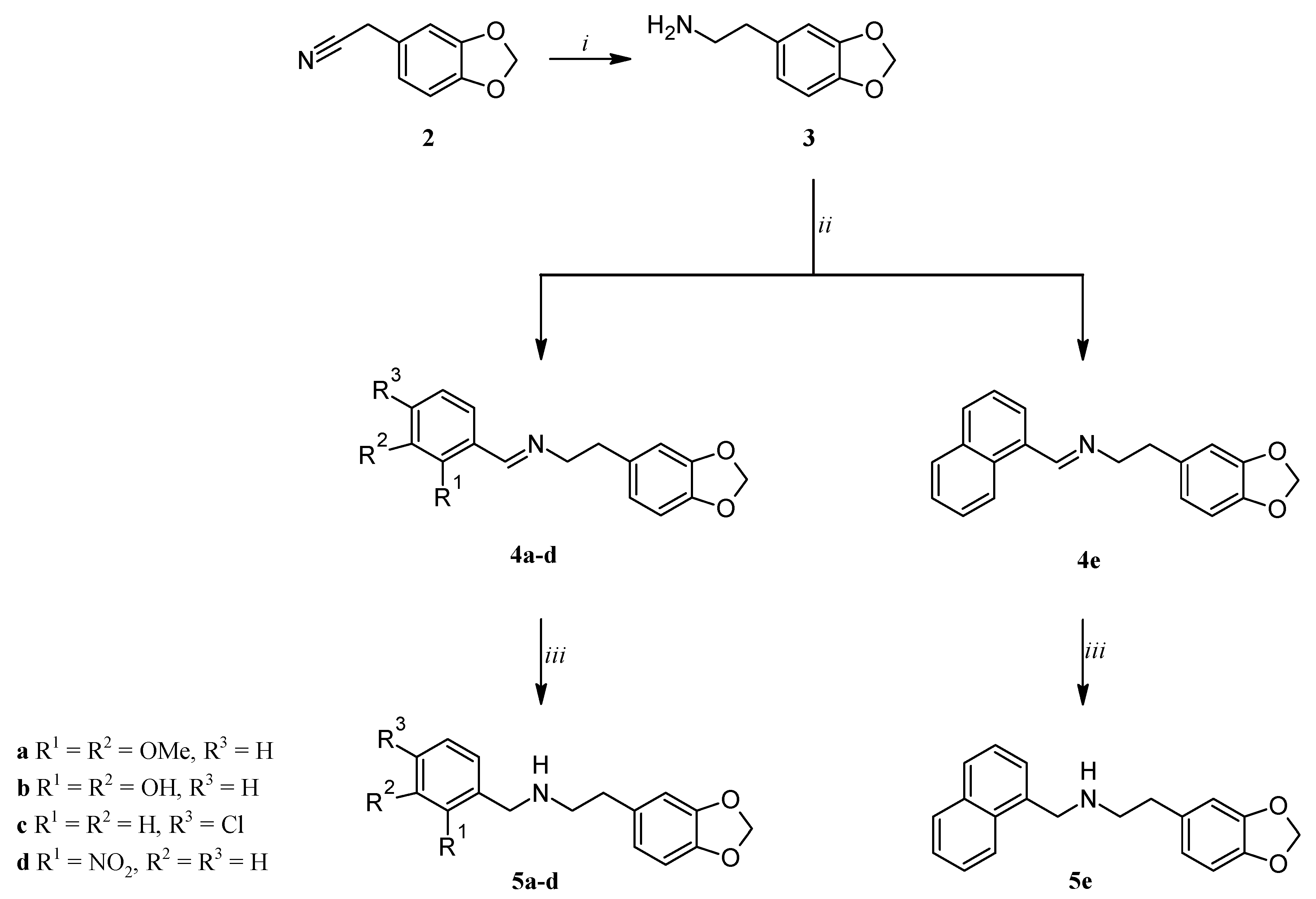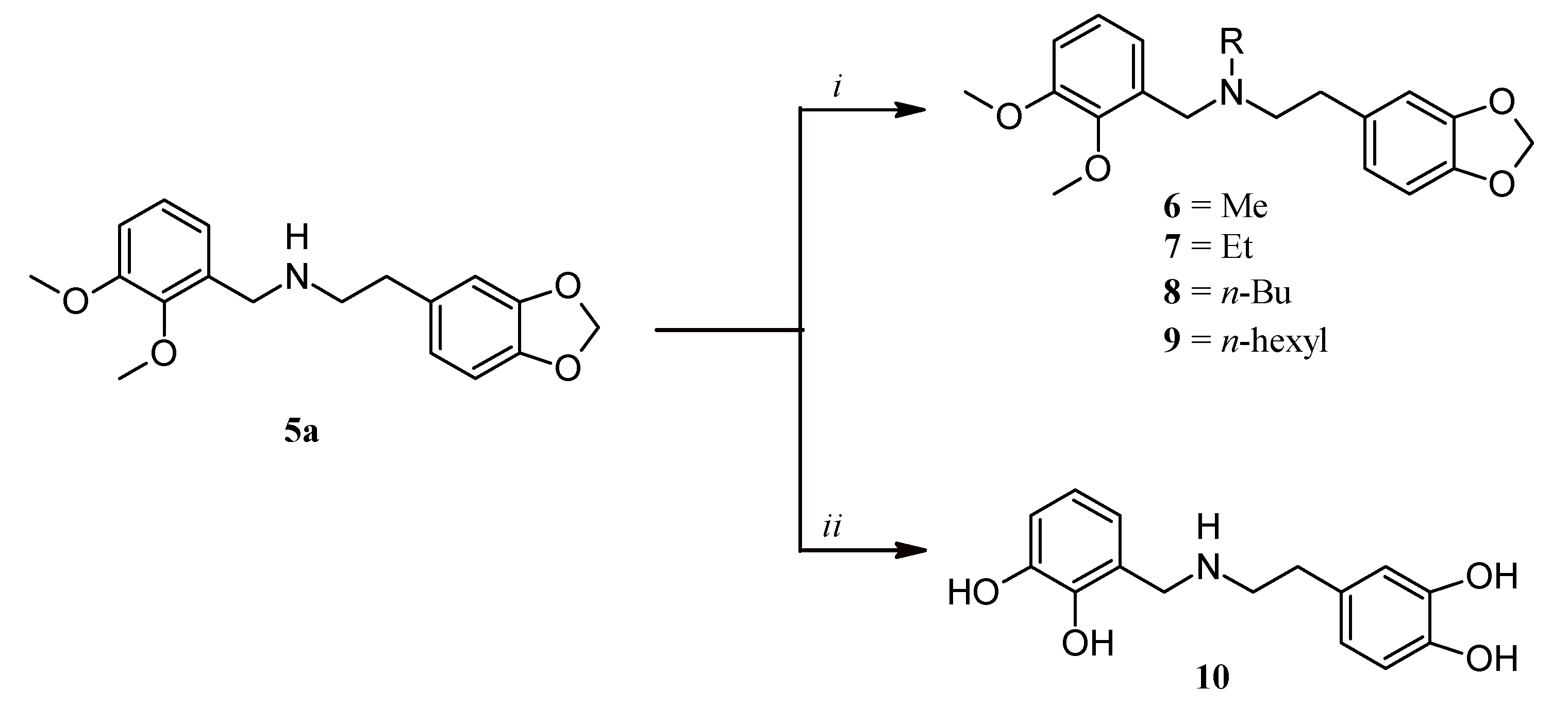Molecular Simplification of Natural Products: Synthesis, Antibacterial Activity, and Molecular Docking Studies of Berberine Open Models
Abstract
1. Introduction
2. Experimental Section
2.1. Chemistry
2.1.1. 2-(3,4-Methylenedioxyphenyl)ethylamine (3)
2.1.2. General Procedure for the Synthesis of Compounds 5c–e
2.1.3. 2-(1,3-Benzodioxol-5-yl)-N-(2,3-dimethoxybenzyl)-N-methylethanamine hydrobromide (6.HBr)
2.1.4. General Procedure for the Synthesis of Compounds 7–9
2.2. Antibacterial Assay
2.3. Molecular Docking Analysis
2.4. Pharmacokinetic Parameters Prediction
3. Results and Discussion
3.1. Chemistry
3.2. Antibacterial Activity
3.3. Molecular Docking Analysis
3.4. Pharmacokinetic Parameters Prediction
4. Conclusions
Author Contributions
Funding
Institutional Review Board Statement
Informed Consent Statement
Data Availability Statement
Conflicts of Interest
References
- Abdallah, E.M. Plants: An alternative source for antimicrobials. J. Appl. Pharm. Sci. 2011, 1, 16–20. [Google Scholar]
- Dorman, H.J.D.; Deans, S.G. Antimicrobial agents from plants: Antibacterial activity of plant volatile oils. J. Appl. Microbiol. 2000, 88, 308–316. [Google Scholar] [CrossRef]
- Gull, I.; Sohail, M.; Aslam, M.S.; Athar, M.A. Phytochemical, toxicological and antimicrobial evaluation of lawsonia inermis extracts against clinical isolates of pathogenic bacteria. Ann. Clin. Microbiol. Antimicrob. 2013, 12, 36–41. [Google Scholar] [CrossRef]
- Manandhar, S.; Luitel, S.; Dahal, R.K. In vitro antimicrobial activity of some medicinal plants against human pathogenic bacteria. J. Trop. Med. 2019, 2019, 1895340. [Google Scholar] [CrossRef]
- Coates, A.; Hu, Y.; Bax, R.; Page, C. The future challenges facing the development of new antimicrobial drugs. Nat. Rev. 2002, 1, 895–910. [Google Scholar] [CrossRef]
- Swamy, M.K.; Akhtar, M.S.; Sinniah, U.R. Antimicrobial properties of plant essential oils against human pathogens and their mode of action: An updated review. Evid. Based Complement. Alternat. Med. 2016, 2016, 3012462. [Google Scholar] [CrossRef]
- Maier, M.M. Design and synthesis of analogues of natural products. Org. Biomol. Chem. 2015, 13, 5302–5343. [Google Scholar] [CrossRef]
- Breinbauer, R.; Vetter, I.R.; Waldmann, H. From protein domains to drug candidates-natural products as guiding principles in the design and synthesis of compound libraries. Angew. Chem. Int. Ed. 2002, 41, 2878–2890. [Google Scholar] [CrossRef]
- Kellenberger, E.; Hofmann, A.; Quinn, R.J. Similar interactions of natural products with biosynthetic enzymes and therapeutic targets could explain why nature produces such a large proportion of existing drugs. Nat. Prod. Rep. 2011, 28, 1483–1492. [Google Scholar] [CrossRef]
- Hann, M.M. Molecular obesity, potency and other addictions in drug discovery. Med. Chem. Commun. 2011, 2, 349–355. [Google Scholar]
- Guo, Z. The modification of natural products for medical use. Acta Pharm. Sin. B 2017, 7, 119–136. [Google Scholar] [CrossRef]
- Crane, E.A.; Gademann, K. Capturing biological activity in natural product fragments by chemical synthesis. Angew. Chem. Int. Ed. 2016, 55, 3882–3902. [Google Scholar] [CrossRef] [PubMed]
- Chen, X.W.; Di, Y.M.; Zhang, J.; Zhou, Z.W.; Li, C.G.; Zhou, S.F. Interaction of herbal compounds with biological targets: A case study with berberine. Sci. World J. 2012, 2012, e708292. [Google Scholar] [CrossRef]
- Grycova, L.; Dostal, J.; Marek, R. Quaternary protoberberine alkaloids. Phytochemistry 2007, 68, 150–175. [Google Scholar] [CrossRef] [PubMed]
- Singh, A.; Duggal, S.; Kaur, N.; Singh, J. Berberine: Alkaloid with wide spectrum of pharmacological activities. J. Nat. Prod. 2010, 3, 64–75. [Google Scholar]
- Cernakova, M.; Kostalova, D. Antimicrobial Activity of Berberine- a Constituent of Mahonia aquifolium. Folia Microbiol. 2002, 47, 375–378. [Google Scholar] [CrossRef]
- Iwasa, K.; Lee, D.-U.; Kang, S.-I.; Wiegrebe, W. Antimicrobial activity of 8-alkyl- and 8-phenyl-substituted berberines and their 12-bromo derivatives. J. Nat. Prod. 1998, 61, 1150–1153. [Google Scholar] [CrossRef]
- Lee, D.-U.; Kang, Y.J.; Kyu Park, M.K.; Lee, Y.S.; Seo, H.G.; Kim, T.S.; Kim, C.-H.; Chang, K.C. Effects of 13-alkyl-substituted berberine alkaloids on the expression of COX-II, TNF-a, iNOS, and IL-12 production in LPS-stimulated macrophages. Life Sci. 2003, 73, 1401–1412. [Google Scholar] [CrossRef]
- Yang, Y.; Ye, X.-L.; Li, X.-G.; Zhen, J.; Zhang, B.; Yuan, L. Synthesis and antimicrobial activity of 8-alkylberberine derivatives with a long aliphatic chain. Planta Med. 2007, 73, 602–604. [Google Scholar] [CrossRef]
- Liu, Y.-X.; Xiao, C.-L.; Wang, Y.-X.; Li, Y.-H.; Yang, Y.-H.; Li, Y.-B.; Bi, C.-W.; Gao, L.-M.; Jiang, J.-D.; Song, D.-Q. Synthesis, structure-activity relationship and in vitro anti-mycobacterial evaluation of 13-n-octylberberine derivatives. Eur. J. Med. Chem. 2012, 52, 151–158. [Google Scholar] [CrossRef] [PubMed]
- Sun, N.; Chan, F.-Y.; Lu, Y.-J.; Neves, M.A.C.; Lui, H.-K.; Wang, Y.; Chow, K.-Y.; Chan, K.-F.; Yan, S.-C.; Leung, Y.-C.; et al. Rational design of berberine-based FtsZ inhibitors with broad-spectrum antibacterial activity. PLoS ONE 2014, 9, e97514. [Google Scholar] [CrossRef]
- Wen, S.-Q.; Jeyakkumar, P.; Avula, S.R.; Zhang, L.; Zhou, C.-H. Discovery of novel berberine imidazoles as safe antimicrobial agents by down regulating ROS generation. Bioorg. Med. Chem. Lett. 2016, 26, 2768–2773. [Google Scholar] [CrossRef] [PubMed]
- Wang, J.; Yang, T.; Chen, H.; Xu, Y.-N.; Yu, L.-F.; Liu, T.; Tang, J.; Yi, Z.; Yang, C.-G.; Xue, W.; et al. The synthesis and antistaphylococcal activity of 9,13-disubstituted berberine derivatives. Eur. J. Med. Chem. 2017, 127, 424–433. [Google Scholar] [CrossRef] [PubMed]
- Yao, L.; Wu, L.-L.; Li, Q.; Hu, Q.-M.; Zhang, S.-Y.; Jiang, J.-Q. Novel berberine derivatives: Design, synthesis, antimicrobial effects, and molecular docking studies. Chin. J. Nat. Med. 2018, 16, 0774–0781. [Google Scholar] [CrossRef]
- Gao, W.-W.; Gopala, L.; Bheemanaboina, R.R.Y.; Zhang, G.-B.; Li, S.; Zhou, C.-H. Discovery of 2-aminothiazolyl berberine derivatives as effectively antibacterial agents toward clinically drug-resistant Gram-negative Acinetobacter baumanii. Eur. J. Med. Chem. 2018, 146, 15–37. [Google Scholar] [CrossRef]
- Fan, T.Y.; Wang, Y.X.; Tang, S.; Hu, X.X.; Zen, Q.X.; Pang, J.; Yang, Y.S.; You, X.F.; Song, D.Q. Synthesis and antibacterial evaluation of 13-substituted cycloberberine derivatives as a novel class of anti-MRSA agents. Eur. J. Med. Chem. 2018, 157, 877–886. [Google Scholar] [CrossRef]
- Yang, Y.-S.; Lu, X.; Zeng, Q.-X.; Pang, J.; Fan, T.-Y.; You, X.-F.; Tang, S.; Wang, Y.-X.; Song, D.-Q. Synthesis and biological evaluation of 7-substituted cycloberberine derivatives as potent antibacterial agents against MRSA. Eur. J. Med. Chem. 2019, 168, 283–292. [Google Scholar] [CrossRef]
- Liu, X.; Zhang, N.; Liu, Y.; Liu, L.; Zeng, Q.; Yin, M.; Wang, Y.; Song, D.; Deng, H. MPB, a novel berberine derivative, enhances lysosomal and bactericidal properties via TGF-β–activated kinase 1-dependent activation of the transcription factor EB. FASEB J. 2019, 33, 1468–1481. [Google Scholar] [CrossRef]
- Yang, Y.-S.; Wei, W.; Hu, X.-X.; Tang, S.; Pang, J.; You, X.-F.; Fan, T.-Y.; Wang, Y.-X.; Song, D.-Q. Evolution and antibacterial evaluation of 8-hydroxy-cycloberberine derivatives as a novel family of antibacterial agents against MRSA. Molecules 2019, 24, 984. [Google Scholar] [CrossRef]
- Kelley, C.; Zhang, Y.; Parhi, A.; Kaul, M.; Pilch, D.S.; LaVoie, E.J. 3-Phenyl substituted 6,7-dimethoxyisoquinoline derivatives as FtsZ-targeting antibacterial agents. Bioorg. Med. Chem. 2012, 20, 7012–7029. [Google Scholar] [CrossRef]
- Cavalluzzi, M.M.; Mangiatordi, G.F.; Nicolotti, O.; Lentini, G. Ligand efficiency metrics in drug discovery: The pros and cons from a practical perspective. Expert Opin. Drug Discov. 2017, 12, 1087–1104. [Google Scholar] [CrossRef]
- Roselli, M.; Cavalluzzi, M.M.; Bruno, C.; Lovece, A.; Carocci, A.; Franchini, C.; Habtemariam, S.; Lentini, G. Synthesis and evaluation of berberine derivatives and analogs as potential antiacetylcholinesterase and antioxidant agents. Phytochem. Lett. 2016, 18, 150–156. [Google Scholar] [CrossRef]
- Boberek, J.M.; Stach, J.; Good, L. Genetic evidence for inhibition of bacterial division protein FtsZ by berberine. PLoS ONE 2010, 5, e13745. [Google Scholar] [CrossRef] [PubMed]
- Domadia, P.N.; Bhunia, A.; Sivaraman, J.; Swarup, S.; Dasgupta, D. Berberine targets assembly of Escherichia coli cell division protein FtsZ. Biochemistry 2008, 47, 3225–3234. [Google Scholar] [CrossRef] [PubMed]
- Mashiach, E.; Schneidman-Duhovny, D.; Andrusier, N.; Nussinov, R.; Wolfson, H.J. FireDock: A web server for fast interaction refinement in molecular docking. Nucleic Acids Res. 2008, 36, W229–W232. [Google Scholar] [CrossRef] [PubMed]
- Salentin, S.; Schreiber, S.; Haupt, V.J.; Adasme, M.F.; Schroeder, M. PLIP: Fully automated protein–ligand interaction profiler. Nucleic Acids Res. 2015, 43, W443–W447. [Google Scholar] [CrossRef] [PubMed]
- Kurkcuoglu, Z.; Koukos, P.I.; Citro, N.; Trellet, M.E.; Rodrigues, J.P.G.L.M.; Moreira, I.S.; Roel-Touris, J.; Melquiond, A.S.J.; Geng, C.; Schaarschmidt, J.; et al. Performance of HADDOCK and a simple contact-based protein–ligand binding affinity predictor in the D3R Grand Challenge 2. J. Comput. Aid. Mol. Des. 2018, 32, 175–185. [Google Scholar] [CrossRef]
- Daina, A.; Michielin, O.; Zoete, V. SwissADME: A free web tool to evaluate pharmacokinetics, drug-likeness and medicinal chemistry friendliness of small molecules. Sci. Rep. 2017, 7, 42717. [Google Scholar] [CrossRef]
- Kim, M.K.; Park, J.C.; Chong, Y. Aromatic hydroxyl group plays a critical role in antibacterial activity of the curcumin analogues. Nat. Prod. Commun. 2012, 7, 57–58. [Google Scholar] [CrossRef]
- Ultee, A.; Bennik, M.H.J.; Moezelaar, R. The phenolic hydroxyl group of carvacrol is essential for action against the food-borne pathogen Bacillus cereus. Appl. Environ. Microbiol. 2002, 68, 1561–1568. [Google Scholar] [CrossRef]
- Carocci, A.; Lentini, G.; Catalano, A.; Cavalluzzi, M.M.; Bruno, C.; Muraglia, M.; Colabufo, N.A.; Galeotti, N.; Corbo, F.; Matucci, R.; et al. Chiral aryloxyalkylamines: Selective 5-HT1B/1D activation and analgesic activity. ChemMedChem 2010, 5, 696–704. [Google Scholar] [CrossRef]
- Bruno, C.; Cavalluzzi, M.M.; Rusciano, M.R.; Lovece, A.; Carrieri, A.; Pracella, R.; Giannuzzi, G.; Polimeno, L.; Viale, M.; Illario, M.; et al. The chemosensitizing agent lubeluzole binds calmodulin and inhibits Ca2+/calmoduline-dependent protein kinase II. Eur. J. Med. Chem. 2016, 116, 36–45. [Google Scholar] [CrossRef] [PubMed]
- Plaza, A.; Keffer, J.L.; Bifulco, G.; Lloyd, J.R.; Bewley, C.A. Chrysophaentins AH, antibacterial bisdiarylbutene macrocycles that inhibit the bacterial cell division protein FtsZ. J. Am. Chem. Soc. 2010, 132, 9069–9077. [Google Scholar] [CrossRef]
- Beuria, T.K.; Santra, M.K.; Panda, D. Sanguinarine blocks cytokinesis in bacteria by inhibiting FtsZ assembly and bundling. Biochemistry 2005, 44, 16584–16593. [Google Scholar] [CrossRef] [PubMed]
- Jaiswal, R.; Beuria, T.K.; Mohan, R.; Mahajan, S.K.; Panda, D. Totarol inhibits bacterial cytokinesis by perturbing the assembly dynamics of FtsZ. Biochemistry 2007, 46, 4211–4220. [Google Scholar] [CrossRef]
- Lock, R.L.; Harry, E.J. Cell-division inhibitors: New insights for future antibiotics. Nat. Rev. Drug Discov. 2008, 7, 324–338. [Google Scholar] [CrossRef]
- Di Somma, A.; Avitabile, C.; Cirillo, A.; Moretta, A.; Merlino, A.; Paduano, L.; Duilio, A.; Romanelli, A. The antimicrobial peptide Temporin L impairs E. coli cell division by interacting with FtsZ and the divisome complex. Biochim. Biophys. Acta Gen. Subj. 2020, 1864, 129606. [Google Scholar] [CrossRef]
- Margalit, D.N.; Romberg, L.; Mets, R.B.; Hebert, A.M.; Mitchison, T.J.; Kirschner, M.W.; RayChaudhuri, D. Targeting cell division: Small-molecule inhibitors of FtsZ GTPase perturb cytokinetic ring assembly and induce bacterial lethality. Proc. Natl. Acad. Sci. USA 2004, 101, 11821–11826. [Google Scholar] [CrossRef]
- Wang, J.; Galgoci, A.; Kodali, S.; Herath, K.B.; Jayasuriya, H.; Dorso, K.; Vicente, F.; Gonzales, A.; Cully, D.; Bramhill, D.; et al. Discovery of a small molecule that inhibits cell division by blocking FtsZ, a novel therapeutic target of antibiotics. J. Biol. Chem. 2003, 278, 44424–44428. [Google Scholar] [CrossRef]
- Czaplewski, L.G.; Collins, I.; Boyd, E.A.; Brown, D.; East, S.P.; Gardiner, M.; Fletcher, R.; Haydon, D.J.; Henstock, V.; Ingram, P.; et al. Antibacterial alkoxybenzamide inhibitors of the essential bacterial cell division protein FtsZ. Bioorg. Med. Chem. Lett. 2009, 19, 524–527. [Google Scholar] [CrossRef]
- Fang, Z.; Li, Y.; Zheng, Y.; Li, X.; Lu, Y.-J.; Yan, S.-C.; Wong, W.-L.; Chan, K.-F.; Wong, K.-Y.; Sun, N. Antibacterial activity and mechanism of action of a thiophenyl substituted pyrimidine derivative. RSC Adv. 2019, 9, 10739–10744. [Google Scholar] [CrossRef]
- Wang, L.; Yang, X.; Li, X.; Stoika, R.; Wang, X.; Lin, H.; Ma, Y.; Wang, R.; Liu, K. Synthesis of hydrophobically modified berberine derivatives with high anticancer activity through modulation of the MAPK pathway. New J. Chem. 2020, 44, 14024–14034. [Google Scholar] [CrossRef]









 | |||||||||||
| Compd | R1 | R2 | R3 | R4 | R5 | X | Gram-Positive | Gram-Negative | |||
| B. subtilis ATCC 6633 | S. aureus ATCC 29213 | E. faecalis ATCC 29212 | E. coli ATCC 25922 | K. pneumoniae ATCC 13883 | |||||||
| 1 | OCH3 | OCH3 | – | – | –CH2– | – | >512 | 512 | >512 | 512 | >512 |
| 5b.HCl | OH | OH | H | H | –CH2– | H2 | 128 | 128 | 256 | 256 | 128 |
| 5c.HCl | H | H | Cl | H | –CH2– | H2 | n.d. | 64 | 128 | 128 | 128 |
| 5d.HCl | NO2 | H | H | H | –CH2– | H2 | n.d. | 128 | 128 | 256 | 512 |
| 5e.HCl | CH=CHCH=CH | H | H | –CH2– | H2 | n.d. | 32 | 64 | 128 | 128 | |
| 6.HBr | OCH3 | OCH3 | H | CH3 | –CH2– | H2 | 256 | 512 | 512 | 128 | 256 |
| 10 | OH | OH | H | H | H | H2 | 256 | 64 | 256 | 256 | 64 |
| 13 | OCH3 | OCH3 | H | H | H | H2 | >512 | 23.75 | >512 | >512 | 23.75 |
| 14 | OCH3 | OCH3 | – | – | H | – | >512 | 64 | 512 | 256 | 64 |
| Protein-Ligand | Interaction | Gibbs Free Energy Variation(ΔG, kcal/mol) | |||
|---|---|---|---|---|---|
| Hydrophobic interactions | Hydrogen bonds | Noncovalent interaction | π-Stacking | ||
| FtsZ-berberine | 2 Met220, Leu378 | 2 Arg258, Lys380 | - | - | −8.02 |
| FtsZ-5b | 1 Asp45 | 7 Ala70, Ala72, Gly107, Thr108, Gly109, Asn165 | 1 Phe182 | - | –7.45 |
| FtsZ-5a | 5 Glu219, Gln340, Leu347, Val358, Leu378 | 2 Thr313, Lys 380 | - | - | –7.87 |
| FtsZ-6 | 3 Ala72, Pro134, Phe182 | 4 Gly20, Ala70, Gly107, Asn165 | - | 1 Phe 182 | –7.96 |
| FtsZ-7 | 2 Ala72, Phe 182 | 3 Gly20, Gly21, Ala71 | - | 1 Phe182 | –7.86 |
| FtsZ-8 | 2 Ala72, Phe182 | 3 Gly21, Gly21, Thr108 | - | - | –7.85 |
| FtsZ-9 | 6 Val157, Glu219, Met220, Tyr222, Pro334, Leu278 | 4 Arg258, Arg258, Thr313, Gln332 | 1 Lys380 | - | –7.71 |
| Compd. | MW | clog Pb | Water Solubility | BBB Permeability | Drug-Likeness c | Lead-Likeness d |
|---|---|---|---|---|---|---|
| Berberine | 371 | 4.42 | Poorly soluble | No | Yes | No e |
| 5b | 287 | 2.90 | Moderately soluble/soluble | Yes | Yes | Yes |
| 6 | 329 | 3.47 | Moderately soluble/soluble | Yes | Yes | Yes |
| 10 | 275 | 2.38 | Soluble | No | Yes | Yes |
| 13 | 303 | 2.48 | Moderately soluble/soluble | Yes | Yes | Yes |
Publisher’s Note: MDPI stays neutral with regard to jurisdictional claims in published maps and institutional affiliations. |
© 2021 by the authors. Licensee MDPI, Basel, Switzerland. This article is an open access article distributed under the terms and conditions of the Creative Commons Attribution (CC BY) license (https://creativecommons.org/licenses/by/4.0/).
Share and Cite
Milani, G.; Cavalluzzi, M.M.; Solidoro, R.; Salvagno, L.; Quintieri, L.; Di Somma, A.; Rosato, A.; Corbo, F.; Franchini, C.; Duilio, A.; et al. Molecular Simplification of Natural Products: Synthesis, Antibacterial Activity, and Molecular Docking Studies of Berberine Open Models. Biomedicines 2021, 9, 452. https://doi.org/10.3390/biomedicines9050452
Milani G, Cavalluzzi MM, Solidoro R, Salvagno L, Quintieri L, Di Somma A, Rosato A, Corbo F, Franchini C, Duilio A, et al. Molecular Simplification of Natural Products: Synthesis, Antibacterial Activity, and Molecular Docking Studies of Berberine Open Models. Biomedicines. 2021; 9(5):452. https://doi.org/10.3390/biomedicines9050452
Chicago/Turabian StyleMilani, Gualtiero, Maria Maddalena Cavalluzzi, Roberta Solidoro, Lara Salvagno, Laura Quintieri, Angela Di Somma, Antonio Rosato, Filomena Corbo, Carlo Franchini, Angela Duilio, and et al. 2021. "Molecular Simplification of Natural Products: Synthesis, Antibacterial Activity, and Molecular Docking Studies of Berberine Open Models" Biomedicines 9, no. 5: 452. https://doi.org/10.3390/biomedicines9050452
APA StyleMilani, G., Cavalluzzi, M. M., Solidoro, R., Salvagno, L., Quintieri, L., Di Somma, A., Rosato, A., Corbo, F., Franchini, C., Duilio, A., Caputo, L., Habtemariam, S., & Lentini, G. (2021). Molecular Simplification of Natural Products: Synthesis, Antibacterial Activity, and Molecular Docking Studies of Berberine Open Models. Biomedicines, 9(5), 452. https://doi.org/10.3390/biomedicines9050452













